Intellectual Property Law Report: Trademark Infringement Case Study
VerifiedAdded on 2022/10/19
|9
|2635
|75
Report
AI Summary
This report provides a comprehensive legal analysis of a trademark infringement case involving Delicious Bakery Pte Ltd and Sweet Treats Pte Ltd. Delicious Bakery, the plaintiff, holds registered trademark rights for "AROMA CAKES," while Sweet Treats, the defendant, has recently used "AROMATIC CAKES." The report examines the key legal principles under the Trademark Act 1998, focusing on trademark definition, distinctiveness, and infringement. It explores whether Sweet Treats infringed Delicious Bakery's trademark rights and assesses potential defenses, including honest use and challenging the validity of the registration. The analysis considers the application of legal principles to the facts, including the similarity of the marks, the distinctiveness of "AROMA CAKES," and the potential for consumer confusion. The report concludes with an assessment of the likelihood of trademark infringement, considering the defense arguments and the overall legal framework. The report draws upon relevant case law, including Nestlé v. Cadbury UK Ltd., Hai Tong Co (Pte) Ltd v Ventree Singapore Pte Ltd, and Mitac International Corp v Singapore Telecommunications Ltd, to support its analysis.
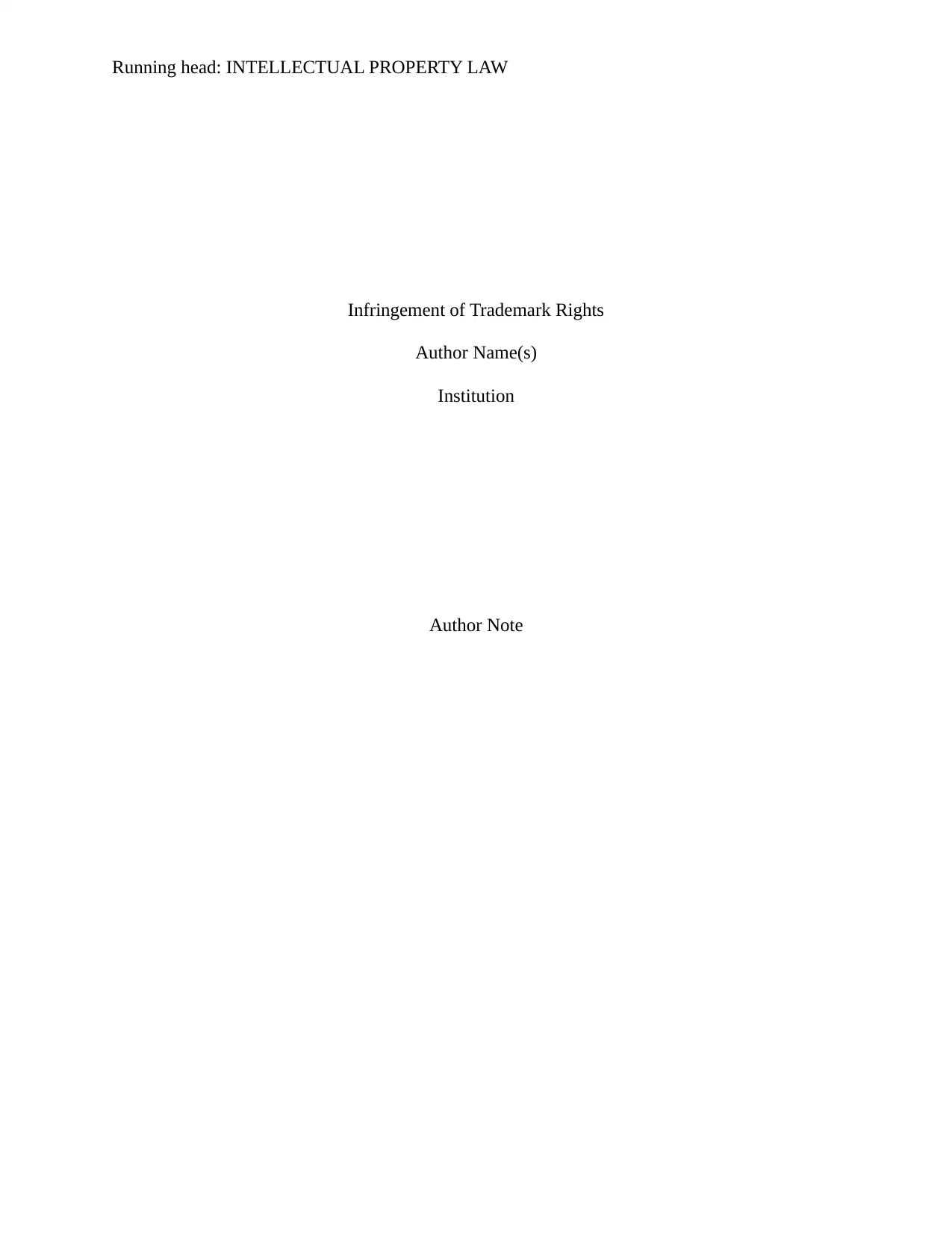
Running head: INTELLECTUAL PROPERTY LAW
Infringement of Trademark Rights
Author Name(s)
Institution
Author Note
Infringement of Trademark Rights
Author Name(s)
Institution
Author Note
Paraphrase This Document
Need a fresh take? Get an instant paraphrase of this document with our AI Paraphraser
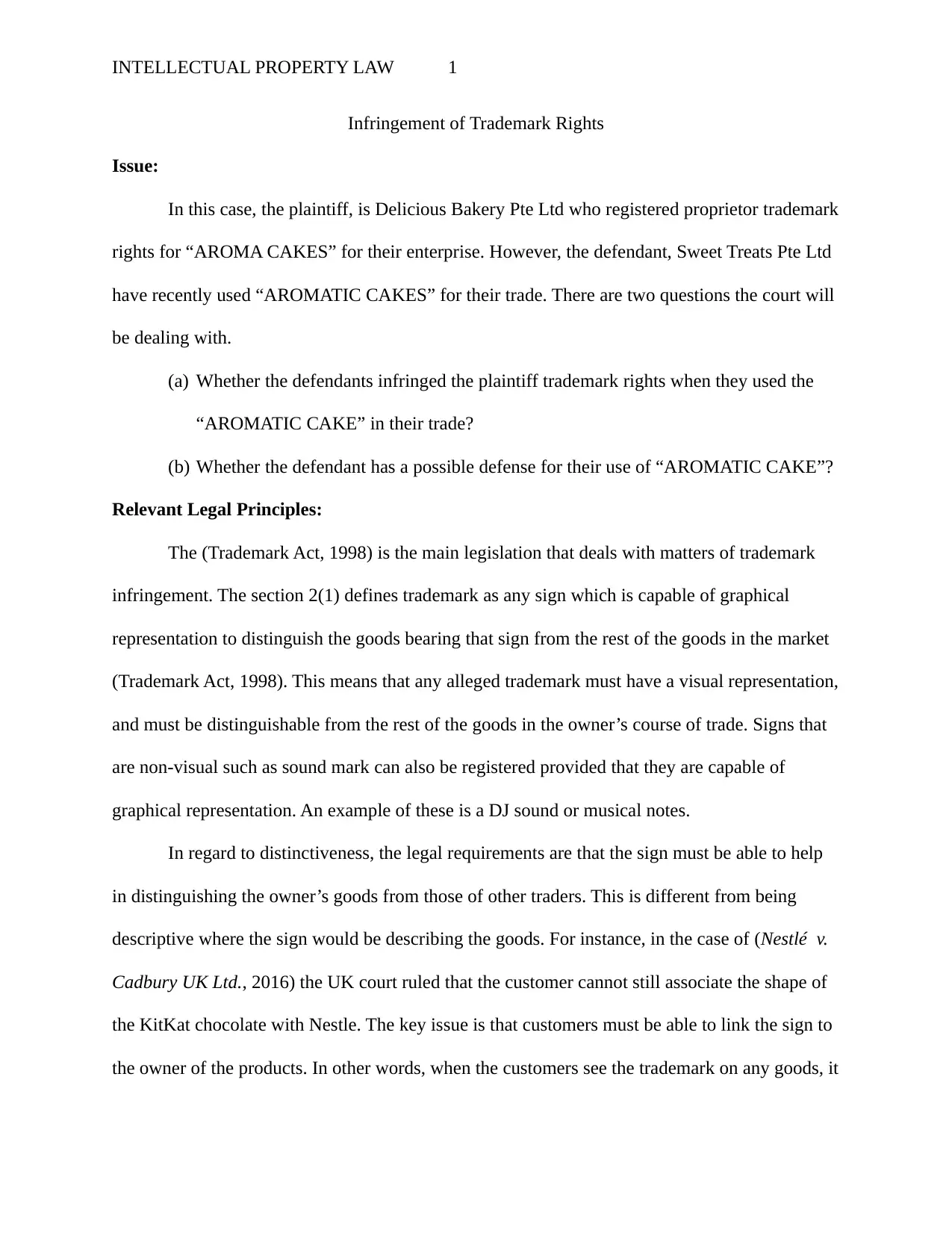
INTELLECTUAL PROPERTY LAW 1
Infringement of Trademark Rights
Issue:
In this case, the plaintiff, is Delicious Bakery Pte Ltd who registered proprietor trademark
rights for “AROMA CAKES” for their enterprise. However, the defendant, Sweet Treats Pte Ltd
have recently used “AROMATIC CAKES” for their trade. There are two questions the court will
be dealing with.
(a) Whether the defendants infringed the plaintiff trademark rights when they used the
“AROMATIC CAKE” in their trade?
(b) Whether the defendant has a possible defense for their use of “AROMATIC CAKE”?
Relevant Legal Principles:
The (Trademark Act, 1998) is the main legislation that deals with matters of trademark
infringement. The section 2(1) defines trademark as any sign which is capable of graphical
representation to distinguish the goods bearing that sign from the rest of the goods in the market
(Trademark Act, 1998). This means that any alleged trademark must have a visual representation,
and must be distinguishable from the rest of the goods in the owner’s course of trade. Signs that
are non-visual such as sound mark can also be registered provided that they are capable of
graphical representation. An example of these is a DJ sound or musical notes.
In regard to distinctiveness, the legal requirements are that the sign must be able to help
in distinguishing the owner’s goods from those of other traders. This is different from being
descriptive where the sign would be describing the goods. For instance, in the case of (Nestlé v.
Cadbury UK Ltd., 2016) the UK court ruled that the customer cannot still associate the shape of
the KitKat chocolate with Nestle. The key issue is that customers must be able to link the sign to
the owner of the products. In other words, when the customers see the trademark on any goods, it
Infringement of Trademark Rights
Issue:
In this case, the plaintiff, is Delicious Bakery Pte Ltd who registered proprietor trademark
rights for “AROMA CAKES” for their enterprise. However, the defendant, Sweet Treats Pte Ltd
have recently used “AROMATIC CAKES” for their trade. There are two questions the court will
be dealing with.
(a) Whether the defendants infringed the plaintiff trademark rights when they used the
“AROMATIC CAKE” in their trade?
(b) Whether the defendant has a possible defense for their use of “AROMATIC CAKE”?
Relevant Legal Principles:
The (Trademark Act, 1998) is the main legislation that deals with matters of trademark
infringement. The section 2(1) defines trademark as any sign which is capable of graphical
representation to distinguish the goods bearing that sign from the rest of the goods in the market
(Trademark Act, 1998). This means that any alleged trademark must have a visual representation,
and must be distinguishable from the rest of the goods in the owner’s course of trade. Signs that
are non-visual such as sound mark can also be registered provided that they are capable of
graphical representation. An example of these is a DJ sound or musical notes.
In regard to distinctiveness, the legal requirements are that the sign must be able to help
in distinguishing the owner’s goods from those of other traders. This is different from being
descriptive where the sign would be describing the goods. For instance, in the case of (Nestlé v.
Cadbury UK Ltd., 2016) the UK court ruled that the customer cannot still associate the shape of
the KitKat chocolate with Nestle. The key issue is that customers must be able to link the sign to
the owner of the products. In other words, when the customers see the trademark on any goods, it
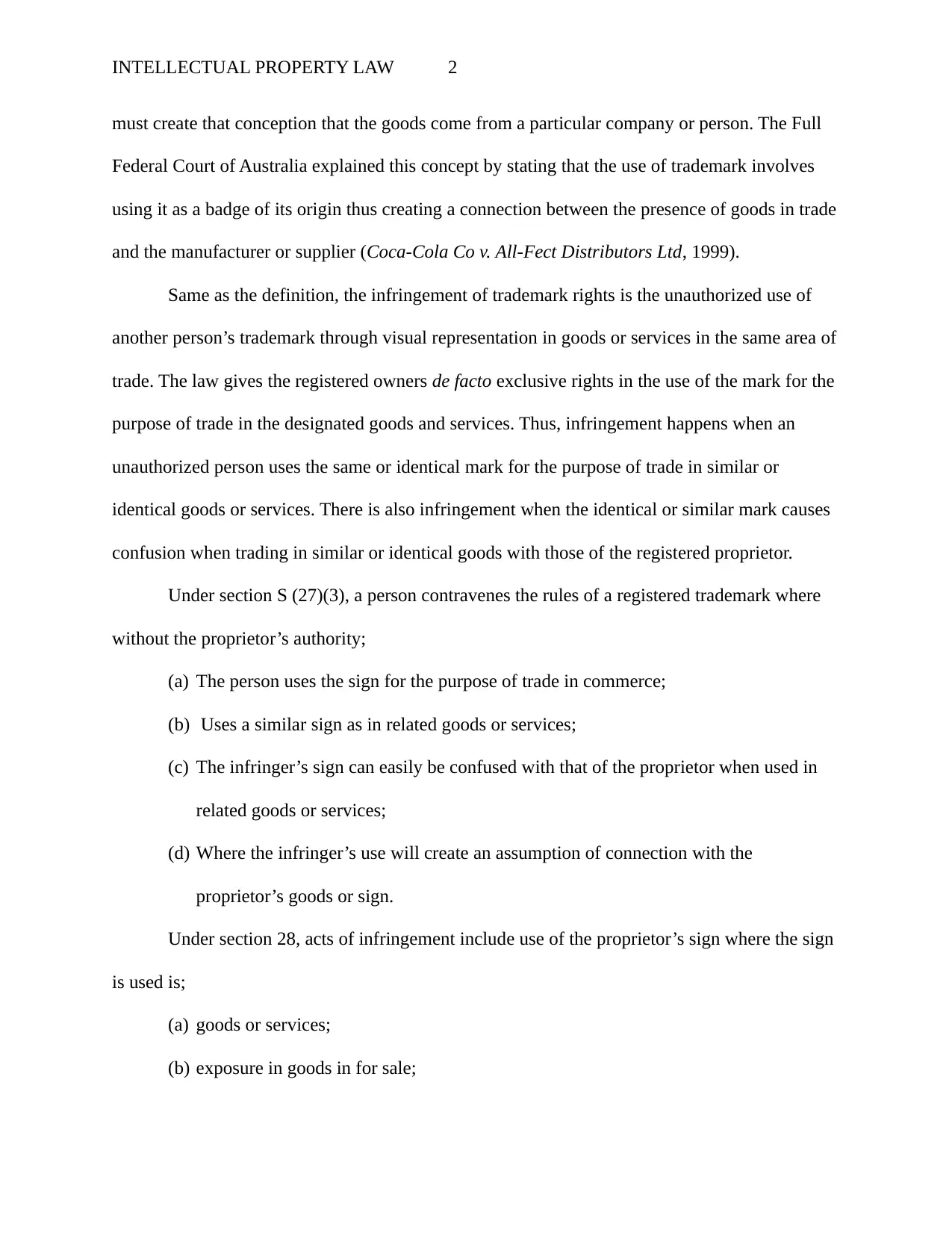
INTELLECTUAL PROPERTY LAW 2
must create that conception that the goods come from a particular company or person. The Full
Federal Court of Australia explained this concept by stating that the use of trademark involves
using it as a badge of its origin thus creating a connection between the presence of goods in trade
and the manufacturer or supplier (Coca-Cola Co v. All-Fect Distributors Ltd, 1999).
Same as the definition, the infringement of trademark rights is the unauthorized use of
another person’s trademark through visual representation in goods or services in the same area of
trade. The law gives the registered owners de facto exclusive rights in the use of the mark for the
purpose of trade in the designated goods and services. Thus, infringement happens when an
unauthorized person uses the same or identical mark for the purpose of trade in similar or
identical goods or services. There is also infringement when the identical or similar mark causes
confusion when trading in similar or identical goods with those of the registered proprietor.
Under section S (27)(3), a person contravenes the rules of a registered trademark where
without the proprietor’s authority;
(a) The person uses the sign for the purpose of trade in commerce;
(b) Uses a similar sign as in related goods or services;
(c) The infringer’s sign can easily be confused with that of the proprietor when used in
related goods or services;
(d) Where the infringer’s use will create an assumption of connection with the
proprietor’s goods or sign.
Under section 28, acts of infringement include use of the proprietor’s sign where the sign
is used is;
(a) goods or services;
(b) exposure in goods in for sale;
must create that conception that the goods come from a particular company or person. The Full
Federal Court of Australia explained this concept by stating that the use of trademark involves
using it as a badge of its origin thus creating a connection between the presence of goods in trade
and the manufacturer or supplier (Coca-Cola Co v. All-Fect Distributors Ltd, 1999).
Same as the definition, the infringement of trademark rights is the unauthorized use of
another person’s trademark through visual representation in goods or services in the same area of
trade. The law gives the registered owners de facto exclusive rights in the use of the mark for the
purpose of trade in the designated goods and services. Thus, infringement happens when an
unauthorized person uses the same or identical mark for the purpose of trade in similar or
identical goods or services. There is also infringement when the identical or similar mark causes
confusion when trading in similar or identical goods with those of the registered proprietor.
Under section S (27)(3), a person contravenes the rules of a registered trademark where
without the proprietor’s authority;
(a) The person uses the sign for the purpose of trade in commerce;
(b) Uses a similar sign as in related goods or services;
(c) The infringer’s sign can easily be confused with that of the proprietor when used in
related goods or services;
(d) Where the infringer’s use will create an assumption of connection with the
proprietor’s goods or sign.
Under section 28, acts of infringement include use of the proprietor’s sign where the sign
is used is;
(a) goods or services;
(b) exposure in goods in for sale;
⊘ This is a preview!⊘
Do you want full access?
Subscribe today to unlock all pages.

Trusted by 1+ million students worldwide
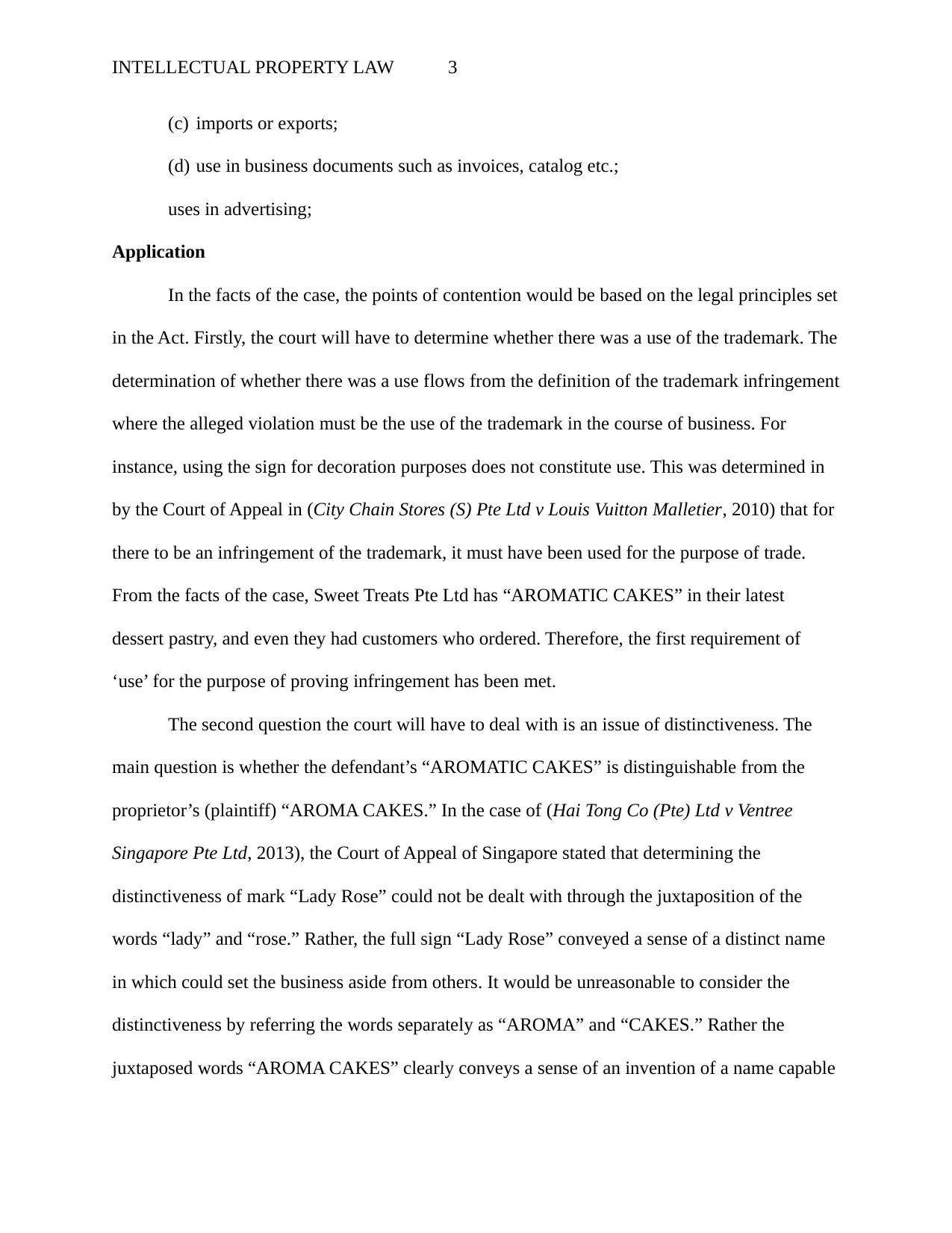
INTELLECTUAL PROPERTY LAW 3
(c) imports or exports;
(d) use in business documents such as invoices, catalog etc.;
uses in advertising;
Application
In the facts of the case, the points of contention would be based on the legal principles set
in the Act. Firstly, the court will have to determine whether there was a use of the trademark. The
determination of whether there was a use flows from the definition of the trademark infringement
where the alleged violation must be the use of the trademark in the course of business. For
instance, using the sign for decoration purposes does not constitute use. This was determined in
by the Court of Appeal in (City Chain Stores (S) Pte Ltd v Louis Vuitton Malletier, 2010) that for
there to be an infringement of the trademark, it must have been used for the purpose of trade.
From the facts of the case, Sweet Treats Pte Ltd has “AROMATIC CAKES” in their latest
dessert pastry, and even they had customers who ordered. Therefore, the first requirement of
‘use’ for the purpose of proving infringement has been met.
The second question the court will have to deal with is an issue of distinctiveness. The
main question is whether the defendant’s “AROMATIC CAKES” is distinguishable from the
proprietor’s (plaintiff) “AROMA CAKES.” In the case of (Hai Tong Co (Pte) Ltd v Ventree
Singapore Pte Ltd, 2013), the Court of Appeal of Singapore stated that determining the
distinctiveness of mark “Lady Rose” could not be dealt with through the juxtaposition of the
words “lady” and “rose.” Rather, the full sign “Lady Rose” conveyed a sense of a distinct name
in which could set the business aside from others. It would be unreasonable to consider the
distinctiveness by referring the words separately as “AROMA” and “CAKES.” Rather the
juxtaposed words “AROMA CAKES” clearly conveys a sense of an invention of a name capable
(c) imports or exports;
(d) use in business documents such as invoices, catalog etc.;
uses in advertising;
Application
In the facts of the case, the points of contention would be based on the legal principles set
in the Act. Firstly, the court will have to determine whether there was a use of the trademark. The
determination of whether there was a use flows from the definition of the trademark infringement
where the alleged violation must be the use of the trademark in the course of business. For
instance, using the sign for decoration purposes does not constitute use. This was determined in
by the Court of Appeal in (City Chain Stores (S) Pte Ltd v Louis Vuitton Malletier, 2010) that for
there to be an infringement of the trademark, it must have been used for the purpose of trade.
From the facts of the case, Sweet Treats Pte Ltd has “AROMATIC CAKES” in their latest
dessert pastry, and even they had customers who ordered. Therefore, the first requirement of
‘use’ for the purpose of proving infringement has been met.
The second question the court will have to deal with is an issue of distinctiveness. The
main question is whether the defendant’s “AROMATIC CAKES” is distinguishable from the
proprietor’s (plaintiff) “AROMA CAKES.” In the case of (Hai Tong Co (Pte) Ltd v Ventree
Singapore Pte Ltd, 2013), the Court of Appeal of Singapore stated that determining the
distinctiveness of mark “Lady Rose” could not be dealt with through the juxtaposition of the
words “lady” and “rose.” Rather, the full sign “Lady Rose” conveyed a sense of a distinct name
in which could set the business aside from others. It would be unreasonable to consider the
distinctiveness by referring the words separately as “AROMA” and “CAKES.” Rather the
juxtaposed words “AROMA CAKES” clearly conveys a sense of an invention of a name capable
Paraphrase This Document
Need a fresh take? Get an instant paraphrase of this document with our AI Paraphraser
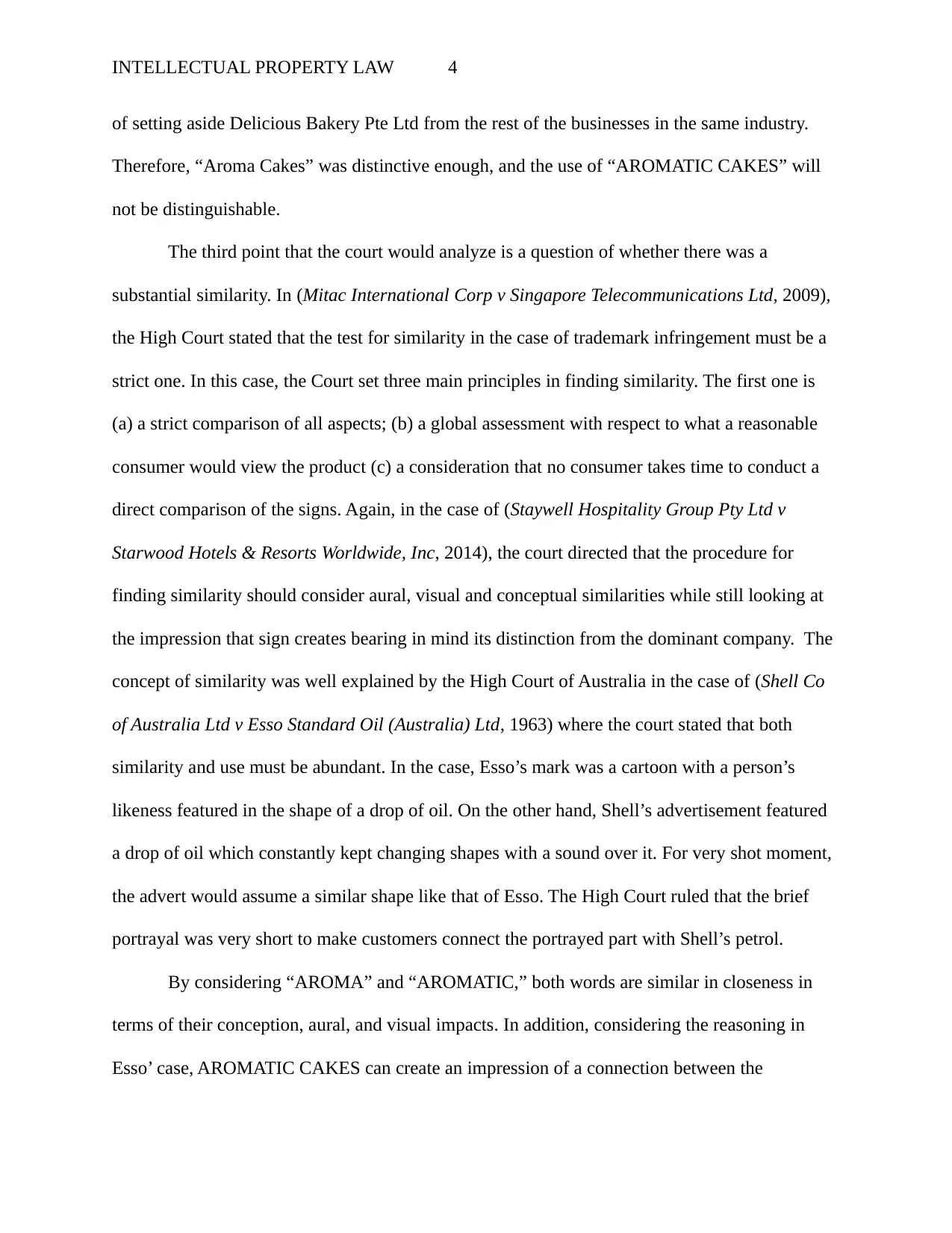
INTELLECTUAL PROPERTY LAW 4
of setting aside Delicious Bakery Pte Ltd from the rest of the businesses in the same industry.
Therefore, “Aroma Cakes” was distinctive enough, and the use of “AROMATIC CAKES” will
not be distinguishable.
The third point that the court would analyze is a question of whether there was a
substantial similarity. In (Mitac International Corp v Singapore Telecommunications Ltd, 2009),
the High Court stated that the test for similarity in the case of trademark infringement must be a
strict one. In this case, the Court set three main principles in finding similarity. The first one is
(a) a strict comparison of all aspects; (b) a global assessment with respect to what a reasonable
consumer would view the product (c) a consideration that no consumer takes time to conduct a
direct comparison of the signs. Again, in the case of (Staywell Hospitality Group Pty Ltd v
Starwood Hotels & Resorts Worldwide, Inc, 2014), the court directed that the procedure for
finding similarity should consider aural, visual and conceptual similarities while still looking at
the impression that sign creates bearing in mind its distinction from the dominant company. The
concept of similarity was well explained by the High Court of Australia in the case of (Shell Co
of Australia Ltd v Esso Standard Oil (Australia) Ltd, 1963) where the court stated that both
similarity and use must be abundant. In the case, Esso’s mark was a cartoon with a person’s
likeness featured in the shape of a drop of oil. On the other hand, Shell’s advertisement featured
a drop of oil which constantly kept changing shapes with a sound over it. For very shot moment,
the advert would assume a similar shape like that of Esso. The High Court ruled that the brief
portrayal was very short to make customers connect the portrayed part with Shell’s petrol.
By considering “AROMA” and “AROMATIC,” both words are similar in closeness in
terms of their conception, aural, and visual impacts. In addition, considering the reasoning in
Esso’ case, AROMATIC CAKES can create an impression of a connection between the
of setting aside Delicious Bakery Pte Ltd from the rest of the businesses in the same industry.
Therefore, “Aroma Cakes” was distinctive enough, and the use of “AROMATIC CAKES” will
not be distinguishable.
The third point that the court would analyze is a question of whether there was a
substantial similarity. In (Mitac International Corp v Singapore Telecommunications Ltd, 2009),
the High Court stated that the test for similarity in the case of trademark infringement must be a
strict one. In this case, the Court set three main principles in finding similarity. The first one is
(a) a strict comparison of all aspects; (b) a global assessment with respect to what a reasonable
consumer would view the product (c) a consideration that no consumer takes time to conduct a
direct comparison of the signs. Again, in the case of (Staywell Hospitality Group Pty Ltd v
Starwood Hotels & Resorts Worldwide, Inc, 2014), the court directed that the procedure for
finding similarity should consider aural, visual and conceptual similarities while still looking at
the impression that sign creates bearing in mind its distinction from the dominant company. The
concept of similarity was well explained by the High Court of Australia in the case of (Shell Co
of Australia Ltd v Esso Standard Oil (Australia) Ltd, 1963) where the court stated that both
similarity and use must be abundant. In the case, Esso’s mark was a cartoon with a person’s
likeness featured in the shape of a drop of oil. On the other hand, Shell’s advertisement featured
a drop of oil which constantly kept changing shapes with a sound over it. For very shot moment,
the advert would assume a similar shape like that of Esso. The High Court ruled that the brief
portrayal was very short to make customers connect the portrayed part with Shell’s petrol.
By considering “AROMA” and “AROMATIC,” both words are similar in closeness in
terms of their conception, aural, and visual impacts. In addition, considering the reasoning in
Esso’ case, AROMATIC CAKES can create an impression of a connection between the
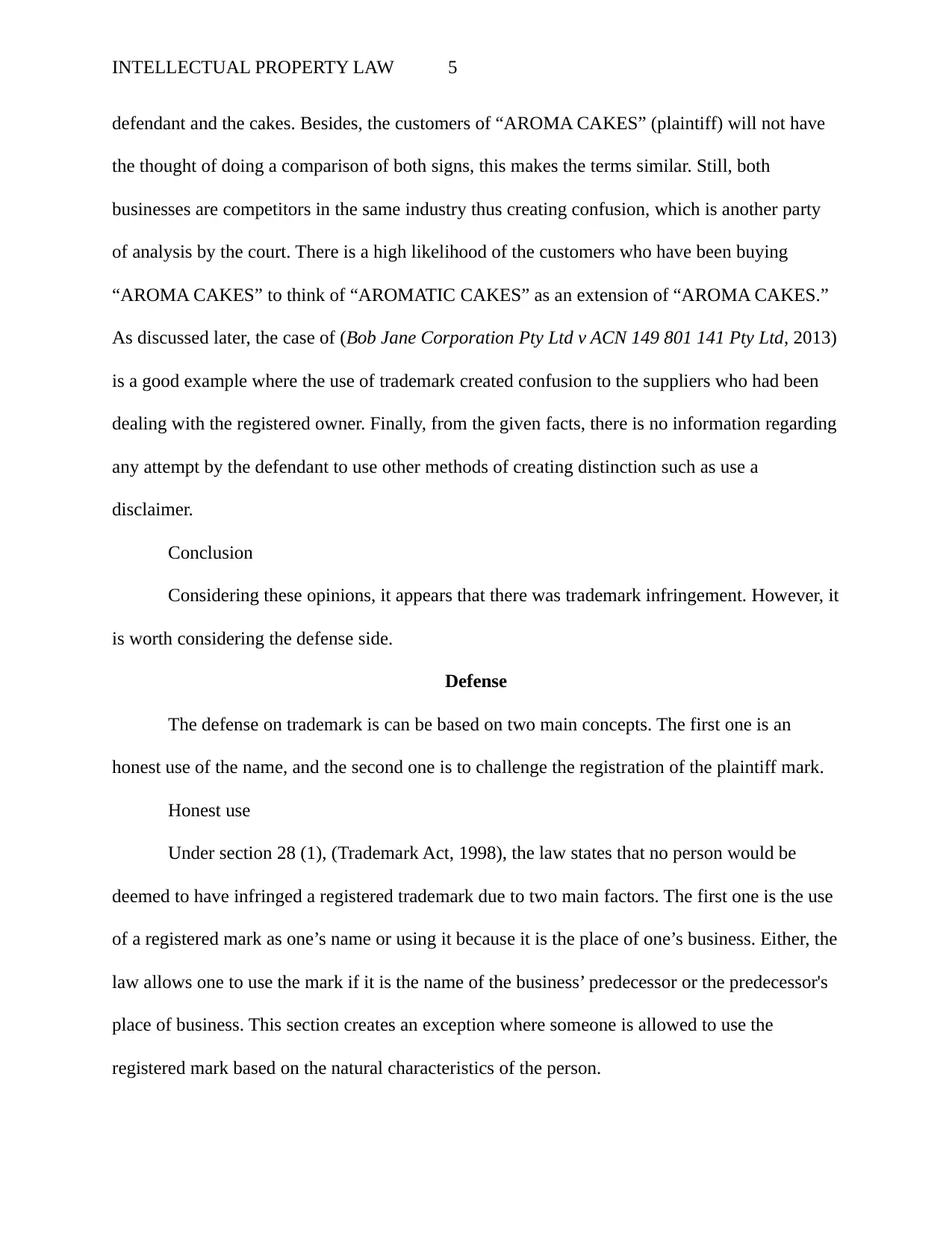
INTELLECTUAL PROPERTY LAW 5
defendant and the cakes. Besides, the customers of “AROMA CAKES” (plaintiff) will not have
the thought of doing a comparison of both signs, this makes the terms similar. Still, both
businesses are competitors in the same industry thus creating confusion, which is another party
of analysis by the court. There is a high likelihood of the customers who have been buying
“AROMA CAKES” to think of “AROMATIC CAKES” as an extension of “AROMA CAKES.”
As discussed later, the case of (Bob Jane Corporation Pty Ltd v ACN 149 801 141 Pty Ltd, 2013)
is a good example where the use of trademark created confusion to the suppliers who had been
dealing with the registered owner. Finally, from the given facts, there is no information regarding
any attempt by the defendant to use other methods of creating distinction such as use a
disclaimer.
Conclusion
Considering these opinions, it appears that there was trademark infringement. However, it
is worth considering the defense side.
Defense
The defense on trademark is can be based on two main concepts. The first one is an
honest use of the name, and the second one is to challenge the registration of the plaintiff mark.
Honest use
Under section 28 (1), (Trademark Act, 1998), the law states that no person would be
deemed to have infringed a registered trademark due to two main factors. The first one is the use
of a registered mark as one’s name or using it because it is the place of one’s business. Either, the
law allows one to use the mark if it is the name of the business’ predecessor or the predecessor's
place of business. This section creates an exception where someone is allowed to use the
registered mark based on the natural characteristics of the person.
defendant and the cakes. Besides, the customers of “AROMA CAKES” (plaintiff) will not have
the thought of doing a comparison of both signs, this makes the terms similar. Still, both
businesses are competitors in the same industry thus creating confusion, which is another party
of analysis by the court. There is a high likelihood of the customers who have been buying
“AROMA CAKES” to think of “AROMATIC CAKES” as an extension of “AROMA CAKES.”
As discussed later, the case of (Bob Jane Corporation Pty Ltd v ACN 149 801 141 Pty Ltd, 2013)
is a good example where the use of trademark created confusion to the suppliers who had been
dealing with the registered owner. Finally, from the given facts, there is no information regarding
any attempt by the defendant to use other methods of creating distinction such as use a
disclaimer.
Conclusion
Considering these opinions, it appears that there was trademark infringement. However, it
is worth considering the defense side.
Defense
The defense on trademark is can be based on two main concepts. The first one is an
honest use of the name, and the second one is to challenge the registration of the plaintiff mark.
Honest use
Under section 28 (1), (Trademark Act, 1998), the law states that no person would be
deemed to have infringed a registered trademark due to two main factors. The first one is the use
of a registered mark as one’s name or using it because it is the place of one’s business. Either, the
law allows one to use the mark if it is the name of the business’ predecessor or the predecessor's
place of business. This section creates an exception where someone is allowed to use the
registered mark based on the natural characteristics of the person.
⊘ This is a preview!⊘
Do you want full access?
Subscribe today to unlock all pages.

Trusted by 1+ million students worldwide
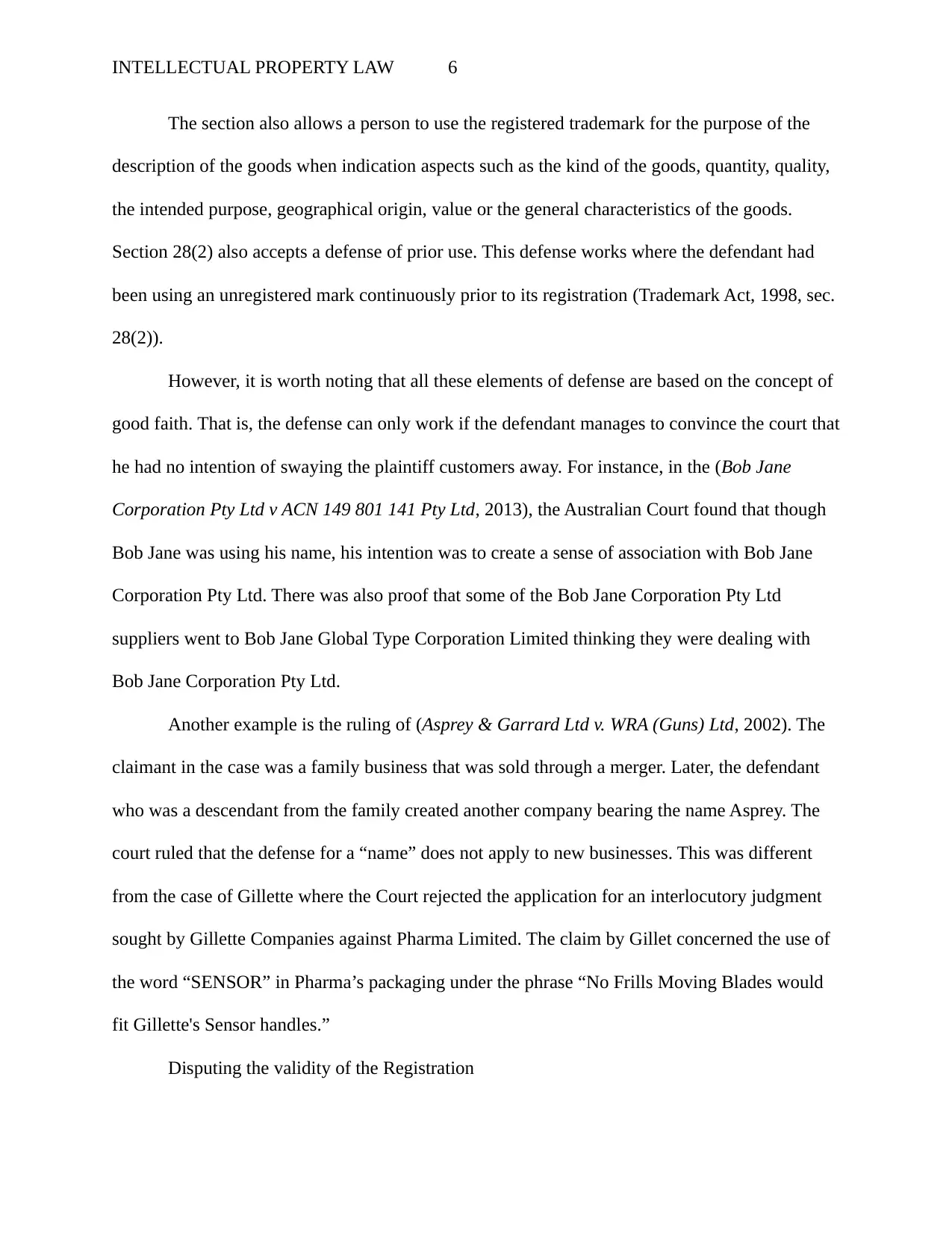
INTELLECTUAL PROPERTY LAW 6
The section also allows a person to use the registered trademark for the purpose of the
description of the goods when indication aspects such as the kind of the goods, quantity, quality,
the intended purpose, geographical origin, value or the general characteristics of the goods.
Section 28(2) also accepts a defense of prior use. This defense works where the defendant had
been using an unregistered mark continuously prior to its registration (Trademark Act, 1998, sec.
28(2)).
However, it is worth noting that all these elements of defense are based on the concept of
good faith. That is, the defense can only work if the defendant manages to convince the court that
he had no intention of swaying the plaintiff customers away. For instance, in the (Bob Jane
Corporation Pty Ltd v ACN 149 801 141 Pty Ltd, 2013), the Australian Court found that though
Bob Jane was using his name, his intention was to create a sense of association with Bob Jane
Corporation Pty Ltd. There was also proof that some of the Bob Jane Corporation Pty Ltd
suppliers went to Bob Jane Global Type Corporation Limited thinking they were dealing with
Bob Jane Corporation Pty Ltd.
Another example is the ruling of (Asprey & Garrard Ltd v. WRA (Guns) Ltd, 2002). The
claimant in the case was a family business that was sold through a merger. Later, the defendant
who was a descendant from the family created another company bearing the name Asprey. The
court ruled that the defense for a “name” does not apply to new businesses. This was different
from the case of Gillette where the Court rejected the application for an interlocutory judgment
sought by Gillette Companies against Pharma Limited. The claim by Gillet concerned the use of
the word “SENSOR” in Pharma’s packaging under the phrase “No Frills Moving Blades would
fit Gillette's Sensor handles.”
Disputing the validity of the Registration
The section also allows a person to use the registered trademark for the purpose of the
description of the goods when indication aspects such as the kind of the goods, quantity, quality,
the intended purpose, geographical origin, value or the general characteristics of the goods.
Section 28(2) also accepts a defense of prior use. This defense works where the defendant had
been using an unregistered mark continuously prior to its registration (Trademark Act, 1998, sec.
28(2)).
However, it is worth noting that all these elements of defense are based on the concept of
good faith. That is, the defense can only work if the defendant manages to convince the court that
he had no intention of swaying the plaintiff customers away. For instance, in the (Bob Jane
Corporation Pty Ltd v ACN 149 801 141 Pty Ltd, 2013), the Australian Court found that though
Bob Jane was using his name, his intention was to create a sense of association with Bob Jane
Corporation Pty Ltd. There was also proof that some of the Bob Jane Corporation Pty Ltd
suppliers went to Bob Jane Global Type Corporation Limited thinking they were dealing with
Bob Jane Corporation Pty Ltd.
Another example is the ruling of (Asprey & Garrard Ltd v. WRA (Guns) Ltd, 2002). The
claimant in the case was a family business that was sold through a merger. Later, the defendant
who was a descendant from the family created another company bearing the name Asprey. The
court ruled that the defense for a “name” does not apply to new businesses. This was different
from the case of Gillette where the Court rejected the application for an interlocutory judgment
sought by Gillette Companies against Pharma Limited. The claim by Gillet concerned the use of
the word “SENSOR” in Pharma’s packaging under the phrase “No Frills Moving Blades would
fit Gillette's Sensor handles.”
Disputing the validity of the Registration
Paraphrase This Document
Need a fresh take? Get an instant paraphrase of this document with our AI Paraphraser
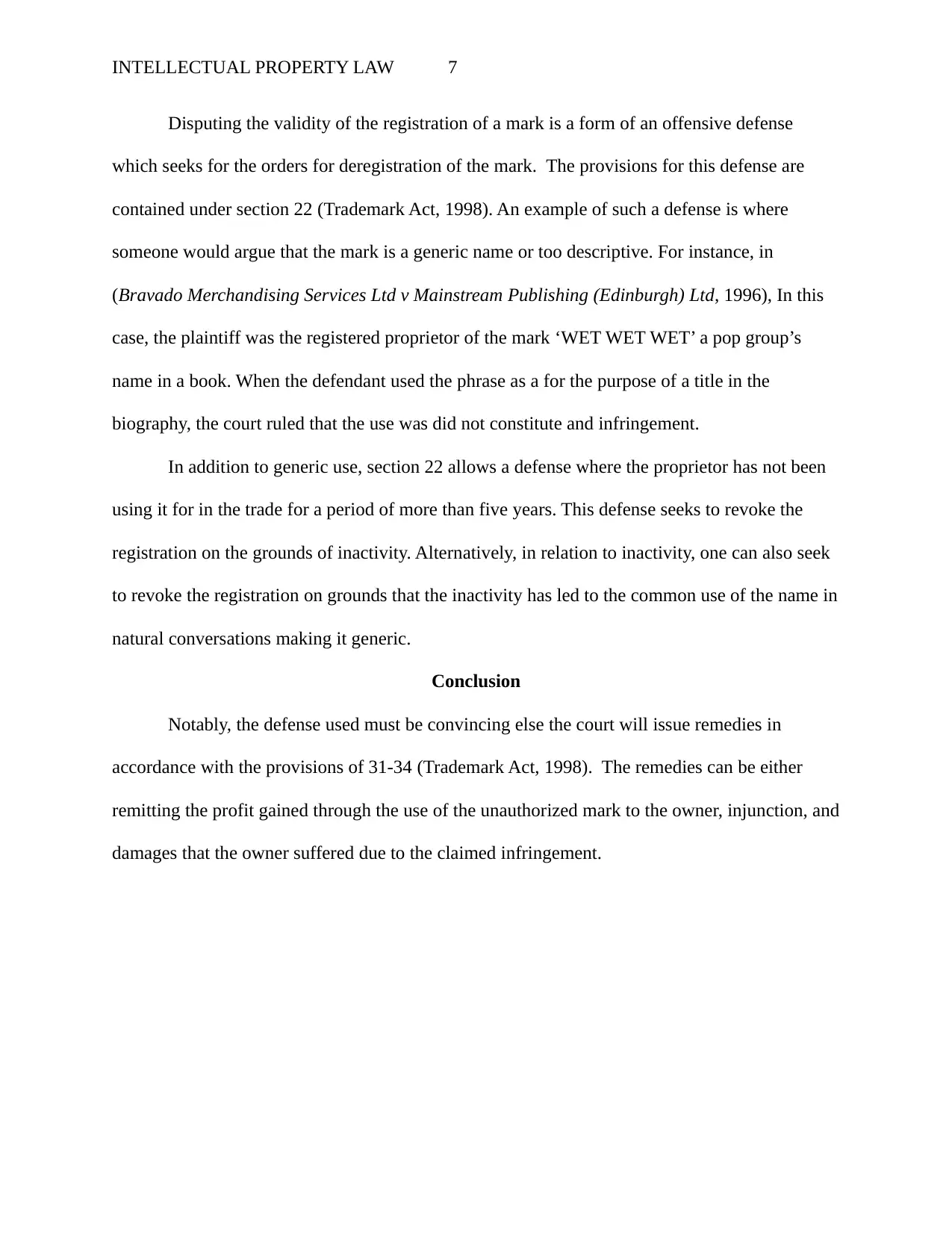
INTELLECTUAL PROPERTY LAW 7
Disputing the validity of the registration of a mark is a form of an offensive defense
which seeks for the orders for deregistration of the mark. The provisions for this defense are
contained under section 22 (Trademark Act, 1998). An example of such a defense is where
someone would argue that the mark is a generic name or too descriptive. For instance, in
(Bravado Merchandising Services Ltd v Mainstream Publishing (Edinburgh) Ltd, 1996), In this
case, the plaintiff was the registered proprietor of the mark ‘WET WET WET’ a pop group’s
name in a book. When the defendant used the phrase as a for the purpose of a title in the
biography, the court ruled that the use was did not constitute and infringement.
In addition to generic use, section 22 allows a defense where the proprietor has not been
using it for in the trade for a period of more than five years. This defense seeks to revoke the
registration on the grounds of inactivity. Alternatively, in relation to inactivity, one can also seek
to revoke the registration on grounds that the inactivity has led to the common use of the name in
natural conversations making it generic.
Conclusion
Notably, the defense used must be convincing else the court will issue remedies in
accordance with the provisions of 31-34 (Trademark Act, 1998). The remedies can be either
remitting the profit gained through the use of the unauthorized mark to the owner, injunction, and
damages that the owner suffered due to the claimed infringement.
Disputing the validity of the registration of a mark is a form of an offensive defense
which seeks for the orders for deregistration of the mark. The provisions for this defense are
contained under section 22 (Trademark Act, 1998). An example of such a defense is where
someone would argue that the mark is a generic name or too descriptive. For instance, in
(Bravado Merchandising Services Ltd v Mainstream Publishing (Edinburgh) Ltd, 1996), In this
case, the plaintiff was the registered proprietor of the mark ‘WET WET WET’ a pop group’s
name in a book. When the defendant used the phrase as a for the purpose of a title in the
biography, the court ruled that the use was did not constitute and infringement.
In addition to generic use, section 22 allows a defense where the proprietor has not been
using it for in the trade for a period of more than five years. This defense seeks to revoke the
registration on the grounds of inactivity. Alternatively, in relation to inactivity, one can also seek
to revoke the registration on grounds that the inactivity has led to the common use of the name in
natural conversations making it generic.
Conclusion
Notably, the defense used must be convincing else the court will issue remedies in
accordance with the provisions of 31-34 (Trademark Act, 1998). The remedies can be either
remitting the profit gained through the use of the unauthorized mark to the owner, injunction, and
damages that the owner suffered due to the claimed infringement.
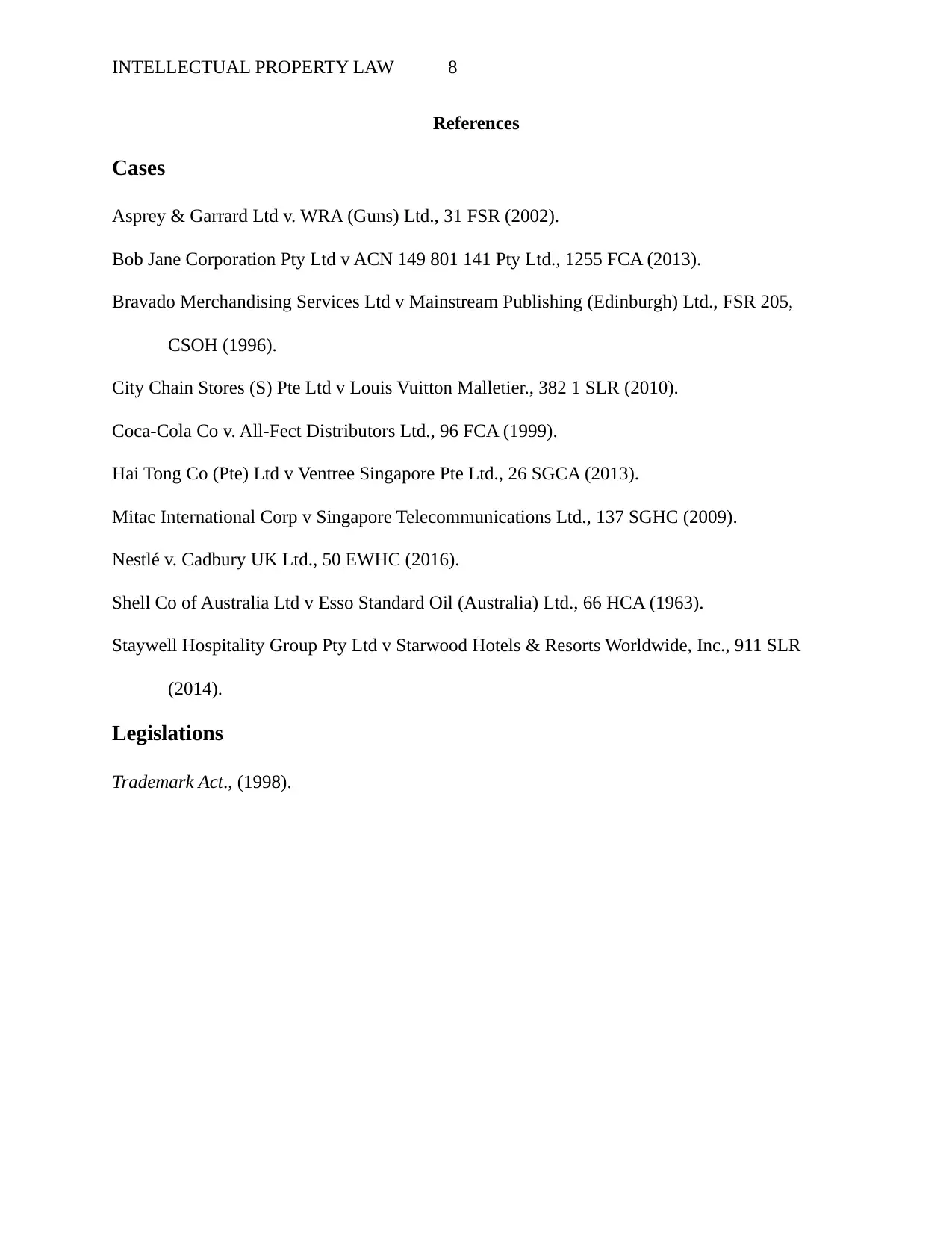
INTELLECTUAL PROPERTY LAW 8
References
Cases
Asprey & Garrard Ltd v. WRA (Guns) Ltd., 31 FSR (2002).
Bob Jane Corporation Pty Ltd v ACN 149 801 141 Pty Ltd., 1255 FCA (2013).
Bravado Merchandising Services Ltd v Mainstream Publishing (Edinburgh) Ltd., FSR 205,
CSOH (1996).
City Chain Stores (S) Pte Ltd v Louis Vuitton Malletier., 382 1 SLR (2010).
Coca-Cola Co v. All-Fect Distributors Ltd., 96 FCA (1999).
Hai Tong Co (Pte) Ltd v Ventree Singapore Pte Ltd., 26 SGCA (2013).
Mitac International Corp v Singapore Telecommunications Ltd., 137 SGHC (2009).
Nestlé v. Cadbury UK Ltd., 50 EWHC (2016).
Shell Co of Australia Ltd v Esso Standard Oil (Australia) Ltd., 66 HCA (1963).
Staywell Hospitality Group Pty Ltd v Starwood Hotels & Resorts Worldwide, Inc., 911 SLR
(2014).
Legislations
Trademark Act., (1998).
References
Cases
Asprey & Garrard Ltd v. WRA (Guns) Ltd., 31 FSR (2002).
Bob Jane Corporation Pty Ltd v ACN 149 801 141 Pty Ltd., 1255 FCA (2013).
Bravado Merchandising Services Ltd v Mainstream Publishing (Edinburgh) Ltd., FSR 205,
CSOH (1996).
City Chain Stores (S) Pte Ltd v Louis Vuitton Malletier., 382 1 SLR (2010).
Coca-Cola Co v. All-Fect Distributors Ltd., 96 FCA (1999).
Hai Tong Co (Pte) Ltd v Ventree Singapore Pte Ltd., 26 SGCA (2013).
Mitac International Corp v Singapore Telecommunications Ltd., 137 SGHC (2009).
Nestlé v. Cadbury UK Ltd., 50 EWHC (2016).
Shell Co of Australia Ltd v Esso Standard Oil (Australia) Ltd., 66 HCA (1963).
Staywell Hospitality Group Pty Ltd v Starwood Hotels & Resorts Worldwide, Inc., 911 SLR
(2014).
Legislations
Trademark Act., (1998).
⊘ This is a preview!⊘
Do you want full access?
Subscribe today to unlock all pages.

Trusted by 1+ million students worldwide
1 out of 9
Related Documents
Your All-in-One AI-Powered Toolkit for Academic Success.
+13062052269
info@desklib.com
Available 24*7 on WhatsApp / Email
![[object Object]](/_next/static/media/star-bottom.7253800d.svg)
Unlock your academic potential
Copyright © 2020–2025 A2Z Services. All Rights Reserved. Developed and managed by ZUCOL.




